Located south of Bogotá in the department of Huila, the Desierto de la Tatacoa, or Tatacoa Desert is one of Colombia’s most unique landscapes and natural attractions.
A visit is well worth a stop when traveling Colombia.
That is doubly true if you will already be traveling through this lesser visited side of northwestern Colombia or you just have a few extra days to spend outside of Bogotá.
Susana and I had long had this on our list of places we wanted to see in Colombia, and we really enjoyed it when we went.
Read on to learn all about the Tatacoa Desert, including how to get there, where to stay, and what to see based on our experience. I’ll also be including some information on possible Tatacoa Desert tours, although this is also doable largely on your own.

*Disclosure: This post contains affiliate links. I am a member of Amazon Associates, LLC and other affiliate programs and earn from qualifying purchases made after clicking those links. There is never any additional cost to you. To learn more please consult our Disclosure Policy.
Tatacoa Desert of Colombia Travel Guide – Contents
- Why Visit the Tatacoa Desert in Colombia
- What to See and Do in the Desierto de la Tatacoa
- How Many Days for the Desierto Tatacoa?
- Doing a Tatacoa Desert Tour vs Going on Your Own
- Where to Stay in the Tatacoa Desert
- Packing List for Colombia’s Tatacoa Desert
- How to Get to the Tatacoa Desert
- Practical Tips
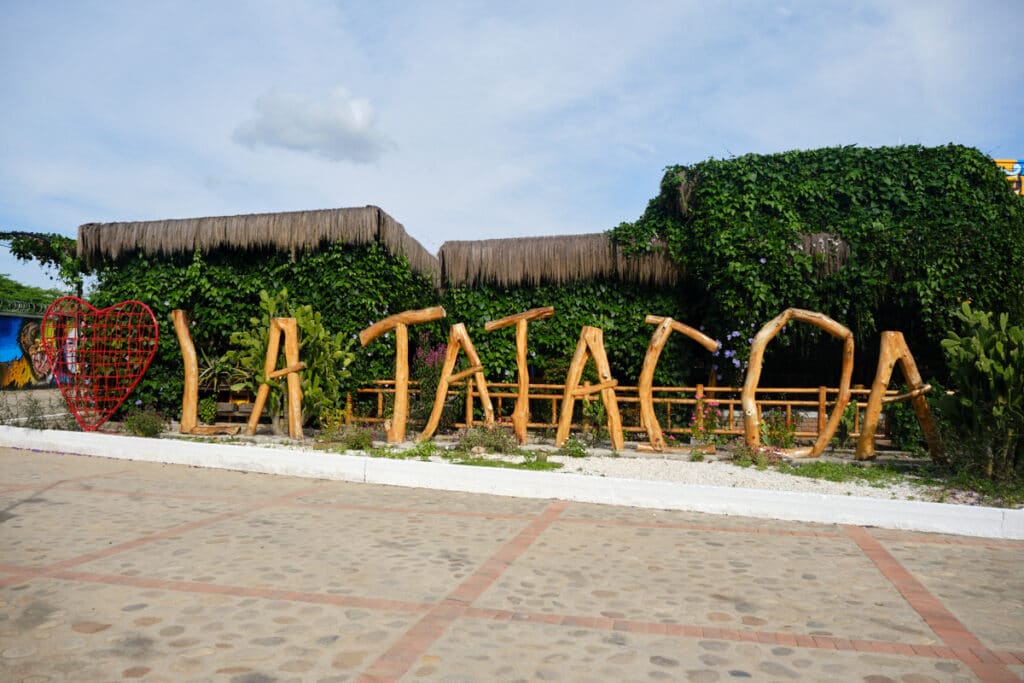
Why Visit the Desierto de la Tatacoa of Colombia
To be honest I hadn’t really heard a whole lot about the Tatacoa Desert until a few years ago when I started seeing more and more photos of it pop up on Instagram and other social media.
Luckily, the Desierto de la Tatacoa is well worth visiting for more than just an Insta photo.
There are some nature and adventure places I would recommend over it like Guaviare, Casanare, Caño Cristales, or Colombia’s other desert of La Guajira and Punta Gallinas, all of which also have stunning landscapes themselves.
However those are all a bit tougher to reach too.
The Tatacoa Desert really is a neat landscape, is fun to explore, and, in an added bonus, it has some of the best star gazing you’ll find anywhere. It also makes for a great stop to split up your travel time if you are traveling or backpacking through this part of western Colombia
So, if you plan to go to San Agustín (which is definitely well worth it), Popayán, Pasto, the lovely Las Lajas Sanctuary, and/or travel to or from Ecuador, you ought to include a stop over in Colombia’s Tatacoa Desert too.
Also, if you just have a couple extra days to travel outside Bogotá, including a a couple nights to see the Desierto de la Tatacoa is totally worth it.

Is the Desierto de la Tatacoa Actually a Desert?
Although called the Desierto de la Tatacoa, it’s technically not a desert but a dry tropical forest.
Tens of millions of years ago, it was a thriving and wet forest. However, it has basically been drying up for millions of years, gradually turning into a desert overtime.
There is actually a lot more plant life and green than I expected.
Meanwhile, the wind and rain the area gets has caused erosion over time, carving out tiny canyons like labyrinths and creating unique shapes in the dried out soil. It’s that process of dry erosion that gives the area its fascinating, almost otherworldly looking landscape.
The Spanish conquistador Gonzalo Jiménez de Quesada called it the Valle de las Tristezas, or “valley of sadness.” The name of Tatacoa was also used by the Spanish to refer to the area in reference to the rattlesnakes they found in the area (don’t worry we didn’t run into any snakes during our time in teh desert!).
Want some help planning your trip to Colombia? Take the hassle out of planning and let the experts at our partner BnB Colombia Tours help you! Fill out this form and they will work with you to design a truly unforgettable, custom made trip. Their packages start at just $200 USD a day. They also offer 2 predesigned multi-city packages that include the Tatacoa Desert: A 5 day trip and a 12 day one.

What to See at the Tatacoa Desert
Well, the desert, of course.
Actually, there are two main areas of the desert, both of which you’ll want to make sure you see during your visit to the Tatacoa Desert.
There is also an additional, longer and lesser known trail that isn’t always included on Tatacoa Desert tours that we did that I thought was absolutely worth it.
Finally, you can’t come here and not go stargazing at the observatory, and the nearby town of Villavieja is worth spending a bit of time exploring too.
Here, I’ll run down everything to see and do in and around the Desierto de la Tatacoa.
Visit the Gray Desert

As I mentioned before, there are two main areas of the desert, each with its own distinctive color.
The first one we visited was the “gray” part of the desert, usually just called the “desierto gris.”
This is the larger of the two areas and has the additional trail (which I’ll talk about below). It tends to get less attention than the “red” desert. I think that may be because photos of the red desert look better as the gray just is hard to see much contrast in photos.
However, the gray part of the Tatacoa Desert is definitely worth visiting and is arguably neater looking in person. In fact, I think overall I found it more interesting walking through this part of the desert and thought the rock formations are much more unique, even if yes, the red is really neat and makes for some great photos.
Here some of the things you can see in the Gray Desert:
Los Hoyos

This is the most visited part of the gray desert of Tataco.
There are a few swimming pools that were built at some point. These look kind of cool in photos, but we thought they didn’t look very enticing in person.
I mean that in the sense both that they didn’t look that nice to swim in and they looked kind of like an eyesore. Honestly, it’s kind of a shame they built them in a natural area like this.
What is definitely worth seeing in this part of the gray Tatacoa Desert is the short trail that goes through the Valle de las Fantasmas, or Valley of Ghosts (I’ve also seen this referred to as the Valle de los Deseos).
The rock formations here are incredibly unique, and get their name because some say they appear to be ghosts or representations of both humans and animals. It’s all very surreal looking.
You might half expect Jabba the Hutt to slither around a corner as it does look a bit like Tatooine (sorry, Star Wars nerd here).
So, while I don’t think the $8,000 fee to swim is worth it, definitely make sure you do the half hour or so walk through the trail to see the rock formations. Do see what you can make out in the shapes, and watch out for the Sarlacc Pit.


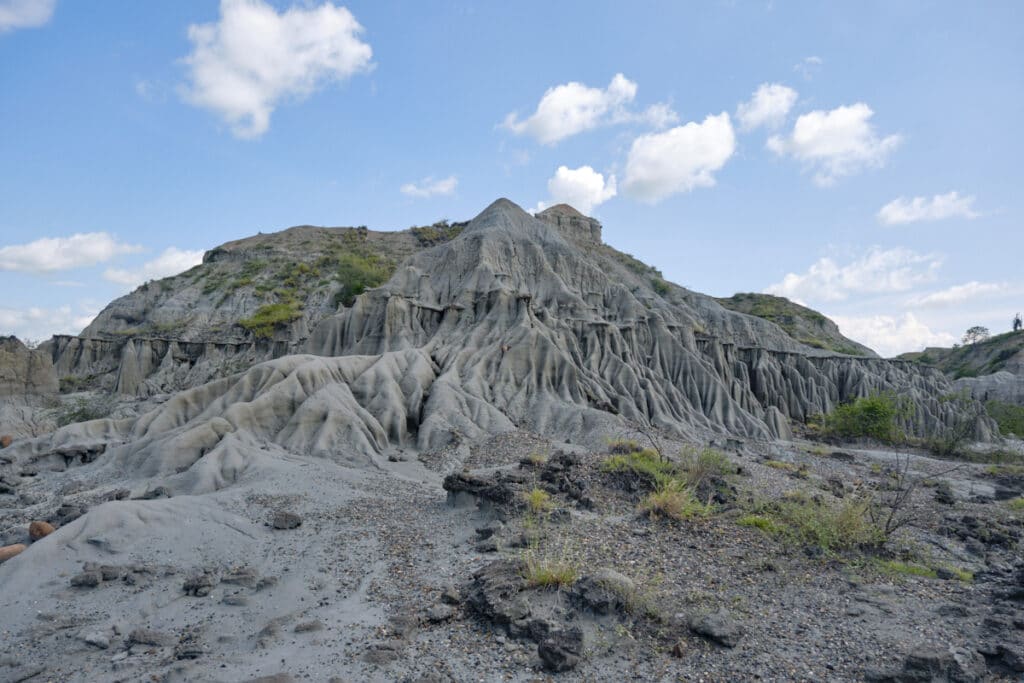

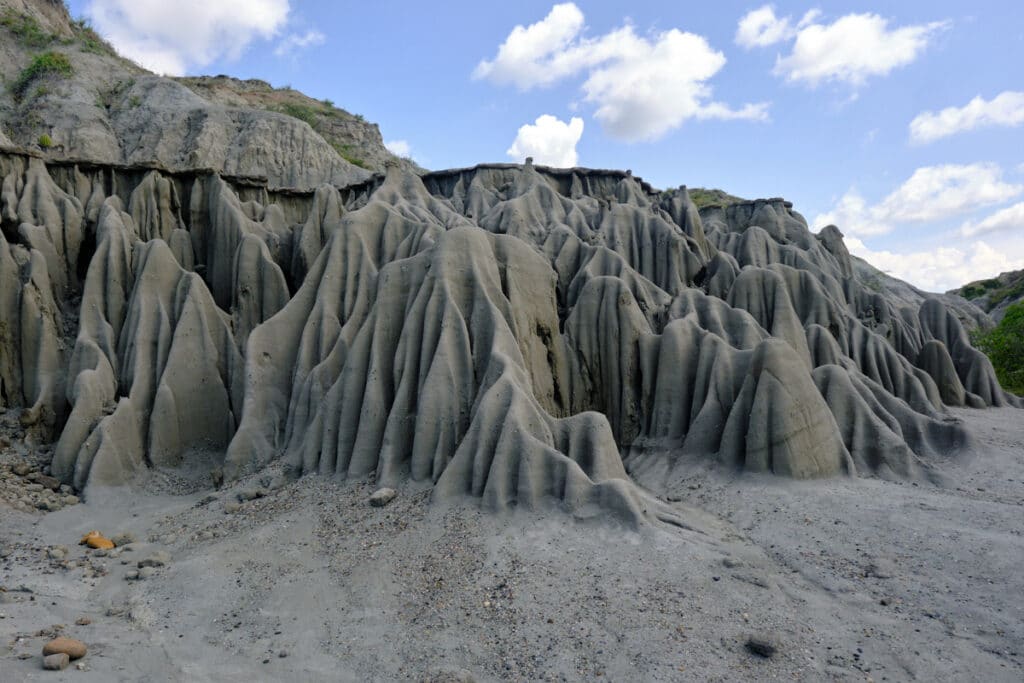

As you can see in these photos, the gray part of the desert of Tatacoa is absolutely fascinating looking.
The rock formations are so unique, and it feels a bit like being on the moon. Plus, while I would skip the pools, they are there if you want them.
There is another lesser visited part of the gray part of the Tatacoa Desert that offers a nice hike that we did, which I’m going to tell you about now.
The Xilópalos Trail

Xilópalos are petrified tree trunks.
They are evidence of the thriving tropical forest ecosystem of millions of years ago. In fact, this area is considered one of the most important in Colombia for the finding of fossils.
There is a trail our guide took us on here that was really cool. The Xilópalos at the end of the trail themselves we didn’t find all that impressive (see the photo above), but the trail itself was nice and absolutely worth including on your tour to the Tatacoa Desert.
It goes over lots of interesting terrain in the gray desert, giving you some more views of the surrounding landcapes.
It also passes through 3 narrow canyons named La Señorita, La Culebra, and El Tiempo. This was the highlight of this trail and why I think it’s worth doing.
It’s really interesting passing through these narrow little tunnels that were carved out by rain drainage over millions of years. As you pass through them you can see how the walls still look more like densely packed sand than rock.



This trail is also not very commonly visited, in fact we didn’t see anyone else on it during our hike.
We did this first as it is the farthest away from where we were staying, so it was also a nice, active way to start the day and our tour of the Tatacoa Desert.
The hike isn’t particularly tough, with just a few short inclined sections, and allows you to see a lot more of the desert and chances to look out for birds, lizards, and other animals.
We were still able to see all of the desert in a day, even with a long lunch and nap break. Therefore, I highly recommend doing this trail, even if it means getting up a little earlier to fit it in to your day.
The Red Desert

This area, known as the Red Desert or “Desierto Rojo” tends to be the more well known part of the desert. If you’ve seen photos of the Tatacoa Desert, probably this is the area you have seen.
Iron in the soil here gives it the rusty, reddish orange, copper look.
If the gray part of the desert looks like the moon or Tatooine, this part feels like Mars. Honestly, it does almost feel like you are walking through a movie set or something. Again, it’s almost hard to believe that these neat rock formations are not man made.
It is really neat looking!
The main area here is known as Cuzco.
You can get some neat views from the top before climbing down and walking along the a short trail that goes through this area. The red, wavy walls look like someone molded them out of clay.
This is probably where I should stop and note that you should not climb on any of the formations. They are, in fact, not actually hard rock but extremely tightly packed sand. Climbing on them can damage them.
Maybe a couple more million years they’ll be hard enough to climb on, but for now stay off so others can enjoy the neat landscape of the Tatacoa Desert for themselves.


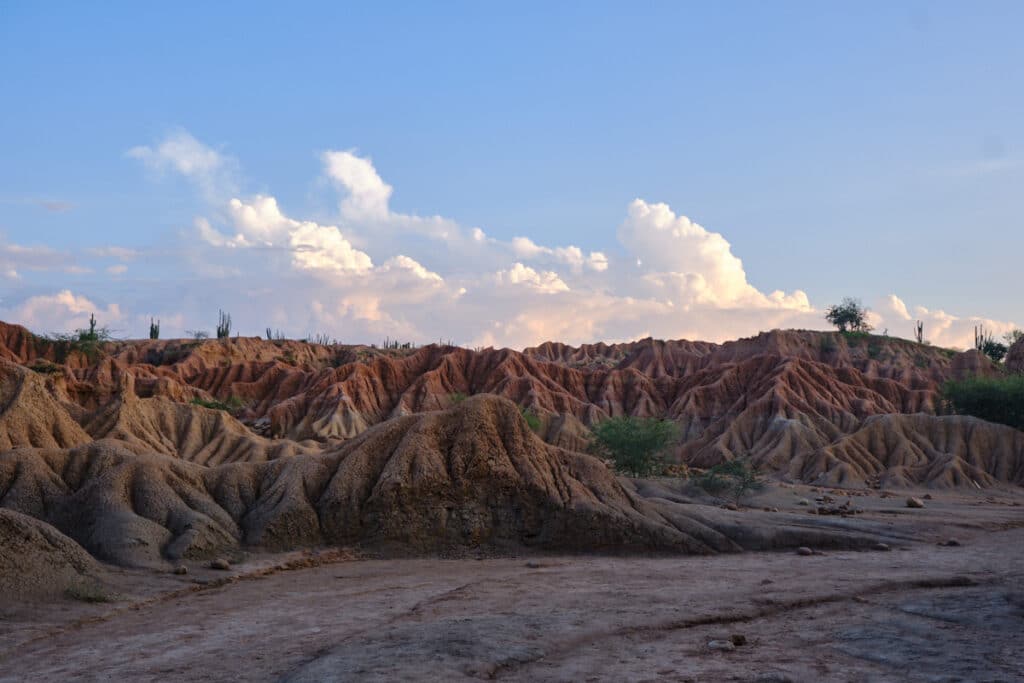

We went here in the afternoon a little bit before sunset.
The sunset was really pretty, but I actually wished we had gotten here a bit earlier as we were a little rushed walking through the trail itself so we wouldn’t get caught by the dark.
Just outside the entrance and exit to the trail there is a little restaurant that has great jugo de caña, or fresh sugarcane juice. It’s the perfect refreshment for cooling off after walking through the heat of the Tatacoa Desert.
That about sums up seeing the Tatacoa Desert itself.
We did all of this in a day, however, there is a great night time activity in the Tatacoa Desert that makes spending a night all but a must that I’m going to tell you about as well.

Stargaze at the AstroSur Observatory
Besides the neat landscape, the Tatacoa Desert is also well known as an excellent place for stargazing and astrophotography.
That makes sense since it’s a large open space with very little development and light pollution that also happens to be extremely close to the Equator.
There are several observatories in the Tatacoa Desert.
We went to the AstroSur Observatory, which had been recommended to us as the best one. It is run by a university professor, who does a great presentation.

We laid back on astroturf (a nice touch!) while he pointed out with a laser pointer the constellations and planets you can see with the naked eye as well as giving a crash course on basic astronomy and its history.
I thought it was a great presentation. He does talk a bit fast, and it is all in Spanish, so those with little or no Spanish might not get quite as much out of this, but I think it’s still worth including on your visit to the Desierto Tatacoa.
Admission was only $10,000 COP (Colombian Pesos), and there were also 6 telescopes set up looking at different constellations, the moon, and Jupiter that you can look through at the end of the presentation. We didn’t see any Star Destroyers or escape pods though.
It was quite crowded and the lines for the telescopes were a bit long, but for the price and great presentation it seemed like a really great value to me.

We didn’t go to the other observatory, so I can’t say for sure this one is better but I thought it was quite good so I’m willing to take the word of the people who recommended it over the other one.
There is a cool little spot just across the street where you can get a light dinner and/or drinks. They have burgers, hot dogs, sandwiches, and salchipapas as well as beers, juices, and other stuff like that. Susana loved their mango biche.
They actually have a neat mirador that overlooks the desert too, and this would be an excellent place to see the sunrise.
We watched the sunset here before walking over to the observatory, and that was nice, albeit on the opposite side of the mirador.


Check out the Town of Villavieja
Villavieja is the nearby town just outside the Tatacoa Desert.
Some people stay at hotels in town and do day tours to the Tatacoa Desert, which may be a good choice if you want nicer accommodations or options for restaurants at night.
However, if you stay in the Desierto de la Tatacoa itself like we did, I still recommend heading into town for a half day if you have the time.
Here, I’ll recount a few of the things we saw in Villavieja as well as a few that were recommended to us but we didn’t have time to do.
There is a Museum of Paleontology (Museo Paleontológico) here. It is ok and has a few neat examples of petrified wood and animal fossils found nearby in the Tatacoa Desert.
However, it was a little disappointing, especially since we waited through the lunch break to see it. It’s pretty weak compared to all the paleontology exhibits in Villa de Leyva, the other place in Colombia known as a major fossil site.
So, I wouldn’t categorize this a must see, but it was cheap and kind of neat if you are in town anyways and don’t show up at lunch time like we did.

We also checked out a neat brewery and ba called La Planta de Cerveza. It was actually still under construction when we went and only part of it was open.
It’s going to be a really neat space once it’s open though!
There is neat street art and murals in the entrance, a cool bar area, and there will even be a pool area when complete. There will also be a brewery tour, although the beer for the time being is still being made elsewhere.

I was a bit disappointed they didn’t have much of a selection and no beers actually on tap.
The two beers they did have that we tried were pretty good though.
However, assuming they finish, I would think by mid-2022 and after this will be a great place to spend a couple hours and enjoy some craft beers made locally.
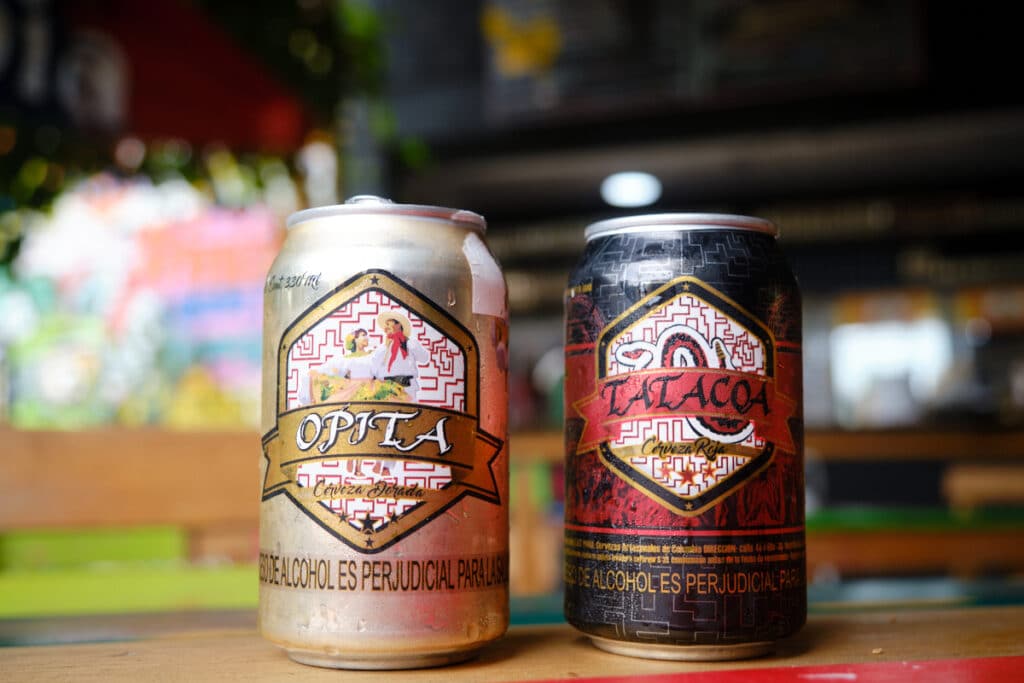
Finally, you can go to the malecón on the Magdelena River.
We heard they offer sunset boat rides and were planning on doing it. We ended up not heading down there before it was too late in the day.
There is also a Casa Museo del Totumo that displays artisan crafts made with Totumo. That sounds like it might also be interesting, especially if you have not seen many things made with Totumo before.
Soak in the PisciLodo
This is another thing we did not do, but it was recommended to us by the family that runs the place we stayed. Not to be confused with the very non natural pools at Los Hoyos, this is supposedly a true natural pool and mud bath.
From photos online it looks like there is a pool where you can swim as well as a mud bath where you can cover yourself with mud in an experience similar to the Mud Volcano near Cartagena. Supposedly this is very good for your skin.
We decided we weren’t all that interested in doing this, but it did come recommended and has good comments online.
So, if it interests you, check it out! Doing town in the morning and this in the afternoon would work well.

How Many Days to Visit?
We stayed 3 nights, and this was perfect for us, especially since we were coming from Bogotá and going to San Agustín next, both more or less full day trips.
That gave us 2 complete days to explore, 1 for the desert and 1 for town.
So, I recommend 3 nights.
If you’re coming from closer or heading somewhere closer after, 2 is probably ok.
2 is probably ok as well if you’re not all that interested in seeing Villavieja as you’ll have a full day to see the desert of Tatacoa itself and if you really jam pack that day you can probably fit in one of town or the Piscilodo too.
I think 1 night would just be too whistle stop unless you are coming from and going to Neiva nearby. That way you can get two near full days.
Otherwise, I would find a way to do at least 2 nights. The other reason I’d say 2 nights is so if it’s cloudy your first night, you have the second night as a backup to do the observatory.
On the other hand, I think staying beyond 3 nights might get a bit boring.
If you want an extra day to relax, that’s cool, especially since there are some hotels with pools that aren’t too crazily priced.
However, I wouldn’t do more than 4 nights at the very most.
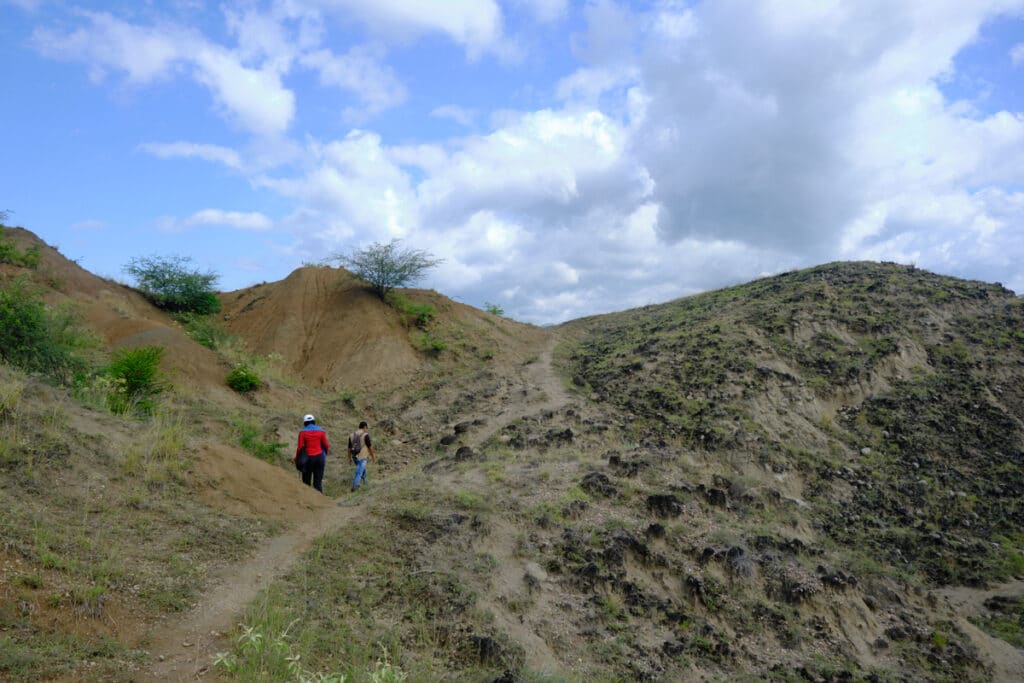
Going with a Tatacoa Desert Tour vs Going on Your Own
I think if you are comfortable navigating Colombian public transportation, have decent Spanish, and have those 3 nights, going on your own is fine. Don’t worry I’m going to go over how to get there below!
Now, I will say, I do think getting a guide for the walks through the desert itself is definitely best. Our guide said several years back a person got lost for several days and nearly died from dehydration before they found him. Beyond the roads, the trails aren’t particularly well marked.
The guide we went with on our Tatacoa Desert tour with works with our hotel. We paid him $240,000 COP. I think that was pretty reasonable since it was all day, just the two of us on a private tour, and it included Tuk-Tuk transportation to and from the Xilópalos trail and Los Hoyos.
I’m sure you can join group tours in the Tatacoa Desert as well for cheaper.
If you only have 1 or 2 nights, a tour package for the entire trip might be a good option. For those with less Spanish or those not wanting to travel by public transportation, I would advise going with doing a Tatacoa tour package.
If you are coming from Bogotá and would like a guided experience (not a bad idea to avoid the delays of buses), you might be interested in this 3 day tour or this 2 day tour from Bogotá.
BnB Colombia, who we have a partnership with, also offers 2 multi-day tours that include visits to the Tatacoa Desert. This 5 day tour goes to Tatacoa, San Agustín, Popayán, and Cali. Meanwhile, this 12 day tour adds a day in Bogotá and goes to Guaviare instead of Cali.
If you’d like a more custom tailored experience that includes a Tatacoa Desert Tour along with other places in Colombia, fill out this form and they will get back to you to help you design a perfect Colombia trip.

Can You Do a Day Trip to the Tatacoa Desert?
If you are really pressed for time, I would say it is possible to do a day trip, but only from Neiva.
However, if you can only spare a day, I would advise booking a Tatacoa Desert tour because public transportation can run on unreliable schedules (we lost more than 3 hours waiting for the bus from Neiva to Villavieja).
Plus, you would miss out on the observatory.
If you would prefer to do a day trip, this day tour is a good option as it includes the observatory and takes you back to Neiva the same evening. Now, if you have your own transportation, I do think you can make a day trip work on your own and still get the observatory in.
Given the fact that there isn’t that much to see in Neiva itself, rather than book end your trip to the desert staying there, I personally would just opt to stay the couple nights in the desert or in Villavieja.

Where to Stay in the Tatacoa Desert
There are quite a few options for where to stay to visit the Desierto de la Tatacoa. There are cheaper lodge style hotels as well as nicer hotels that offer cabins and even fancy Tatacoa Desert glamping experiences. There are a few limited options for Desierto de la Tatacoa camping too.
You also have the option of staying in the Tatacoa Desert itself or staying in Villavieja, which is only a half hour or so away from the main sites in the desert by tuk tuk. I’m going to give suggestions for both where to stay in the Tatacoa Desert and where to stay in Villavieja below.
Where to Stay in the Tatacoa Desert
We were really pleased with where we stayed, which was sort of a mix between a Tatacoa Desert hostel, hotel, and guesthouse, and I’d definitely recommend it. I do, however have a few more options for Tatacoa Desert hotels and hostels below.
Casa del Campo Los Cactus – Where We Stayed – Highly Recommended

We stayed our 3 nights at Casa del Campo los Cactus and thought it was great.
It’s almost directly in the middle of the desert, half way between the gray desert and the red desert. It’s just a 5 minute walk to the AstroSur Observatory too, which made it very convenient.
We stayed in a small cabin made from recycled soda bottles like the one in the photo. There are several of these cabins as well as some rooms in the main house itself. Some have multiple beds, making this a good option for groups and families too.
It is a family run establishment and the family was super friendly, plus they have an in house guide who we did our tour with. We thought the price was very reasonable as well. It’s certainly not luxury but its comfortable and a good value.
I definitely recommend it for where to stay in the Tatacoa Desert.
Infinito Tatacoa – Luxury Glamping in the Desierto de Tatacoa

If you’re looking for a luxury Desierto de la Tatacoa hotel, or glamping in the Tatacoa Desert, check out Infinito Tatacoa.
A newer place, they offer lovely, luxury glamping style bungalows. Designed based on traditional indigenous homes, it’s a unique look for a vacation cabin.
It is on the very pricey side, but the place looks incredible. There is a spa and a pool on site as well. If you want a luxury experience in the Tatacoa Desert, this is definitely the place for it.
Qji Glamping – More Modestly Priced Desierto de la Tatacoa Glamping

Qji Glamping Biohotel offers bungalows in the desert at prices about half the price of Infinito.
It’s not nearly as luxury looking but still offers nice looking, bamboo style bungalows. There is a pool on site and this Tatacoa Desert glamping is only a short walk from Los Hoyos and the Xilópalos trail.
It makes for a good option for those who want slightly nicer accommodations in the desert itself but don’t have the budget for the snazzier Infinito.
Tubo Hotel – Most Unique Hotel in the Tatacoa Desert
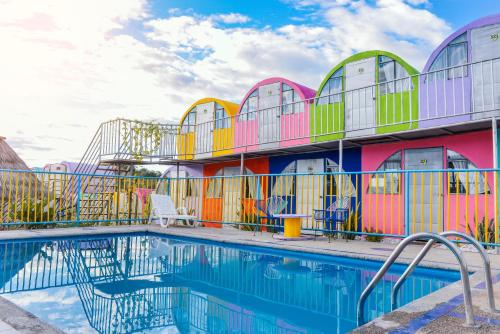
This is a neat looking place and an interesting concept.
In fact, we almost booked here!
Tubo Hotel has small, pod style rooms in giant tubes. It is really colorful with each of the tubes painted different colors and lots of multi-colored common areas. There is also a pool here.
the only downside though is it’s located just outside of Villlavieja and not deep in the desert. It has sort of a hostel atmosphere too, so if you’re looking to meet other travelers and want a pool or looking for place that feel like a hostel in the Tatacoa Desert at more affordable prices than the places above, it’s a good choice.
Pachingo – Best Place for Camping in the Tatacoa Desert

If you want to camp in the Tatacoa Desert, Pachingo is the best option.
Their tents are up on their own little platforms in the desert and there are decent looking bathroom facilities available. There is also a cabin available although it is a good deal pricier than the tents and comparable in price to Qji above.
If it were me, I’d probably rather just pay the little bit more it costs to stay in a room at Casa del Campo los Cactus but if you really want to say you’ve gone camping in the Tatacoa Desert, this is the place to do it.
Places to Stay in Villavieja
If you choose to stay at one of the hotels or hostels in the Tatacoa Desert, you will have limited options for food or things to do at night. Given the close proximity to the observatory and bar/restaurant, this is another big plus for Los Cactus in my opinion.
However, if you want more options while also staying hotel near the Tatacoa Desert, you are better off booking a place to stay in Villavieja.
Here are some good options for where to stay in Villavieja.
Sueño Real Tatacoa – Best Hotel in Villavieja

Located on the edge of town, Sueño Real Tatacoa is a good choice if you want to have a bit more amenities than you’ll find in the hotels in the Tatacoa Desert itself.
The rooms are nice here, there is a great looking pool, and the price is a pretty decent value.
So, if you would prefer to be in a more standard style hotel with the added benefits of a pool and being located in town, this is the best option.
Hotel Colonial Villavieja – Highly Rated Villavieja Hotel

The Hotel Colonial Villavieja is very highly rated online (and has lots of reviews, always a good sign in my opinion).
It’s not particularly fancy, but there is a nice looking pool, and the price is a pretty good value here too (in fact most of these hotels in Villavieja are similarly priced). It is also located in the heart of town.
It’s a good option for where to stay in Villavieja without a doubt.
Hotel Villa Paraiso – Another Solid Option in Town

The Hotel Villa Paraiso makes for another good option for a hotel in Villavieja.
There is a small pool here, and there is also a playground, making this a good choice for families. All their rooms have A/C and they look cozy and comfortable.
Overall, this looks like a decent value for those looking for modest accommodations in town.
Hotel Oasis de Tatacoa – New, Modest Hotel in Villavieja

The Oasis de Tatacoa is a fairly newer hotel in Villavieja.
There is a restaurant here, and it’s a pretty large hotel for a small town like Villavieja.
Unfortunately, there’s no pool, so I’d probably recommend the other places above over this one since they are only a tad more expensive. Still, this looks like a good option if you don’t care about the pool.
Sol del Desierto – Villavieja Hostel Option

This is the only place with dorms that I know of, or at least the only one listed online.
For some reason, the Booking.com page only shows the dorm as a 10 person room that you have to book all together, but you can book the individual beds at HostelWorld.com.
With privates comparable to prices at the other places above and a small pool on site, it’s not a bad value for a private either, and makes the best choice for those looking for a cheap dorm bed or Villavieja hostel near the Tatacoa Desert.
Packing List for the Desierto de la Tatacoa
Generally speaking, you want comfortable stuff for the heat you don’t mind sweating in.
Something like hiking boots is also helpful, especially if you want to do the longer Xilópalos hike but solid and comfortable tennis shoes or walking shoes would also fine.
Sandals will probably be ok for the shorter two main trails.
If you want to do the PisciLodo or stay at a place with a pool, you’ll also want to bring along a bathing suit.
General Travel Gear to Pack





- Susana and I both have the Osprey Porter 46 and love them. It holds a ton and can be used as a carry on for most flights. For something slightly smaller but more comfortable to wear as a backpack, check out the Farpoint 40 or, for the ladies, the Farview 40.
- I love my Roam packable backpack too. It’s perfect to pack and use as a daypack.
- A good hat is useful for Tatacoa and the hot sun. These straw hats are all the rage now. You can get a girl’s version too. Or you could just opt for a standard ball cap or bucket hat for even more sun protection.
- A good water bottle is useful. It will save you some pesos and be better for the environment as big jugs and bags of water are cheap all over Colombia. Lots of people love LifeStraw bottles that include filters so you can drink tap water at places like the Tatacoa Desert too. A SteriPen can also be useful to have.
- It is also a good idea to take along a little mini-flashlight for walking back to your hotel or hostel after the observatory.
Clothes to Pack for Her





- These tank tops are perfect for the hot weather in Tatacoa.
- These safari shirts that provide UV protection would be great as well.
- Something like these long sleeve tees to prevent sunburn isn’t a bad idea either.
- Susana loves wearing athletic leggings outdoors too. A comfy pair of capris works well.
- Finally, these Merrell hiking shoes would be perfect for the Tatacoa Desert.
Clothes to Pack for Him





- Columbia’s mens tees are also comfy for outdoor activities. As are their button ups, which have UV protection for the hot sun in the Tatacoa Desert.
- These long sleeve athletic tees are also good for preventing getting sunburn.
- These quick dry cargo hiking shorts would be perfect for the Desierto de la Tatacoa.
- And for long pants, these Columbia Silver Ridge pants would be good. I’m also a big fan of these Wrangler pants.
- Merrell hiking shoes are a good option for the guys to wear in the Tatacoa Desert too.
How to Get to the Tatacoa Desert
To get to the Tatacoa Desert, you will need to get to the town of Villavieja first.
From Villavieja, you can take Tuk-Tuk motorcycles out to the desert itself. It cost us $25,000 pesos to go to Casa del Campo Los Cactus. You can get them from the central plaza in Villavieja. It may cost a little more or less if you are staying farther away or closer to town.
If you are staying in Villavieja itself, booking a tour like this one to the desert may be cost and time effective, especially if it includes transportation between the two sides of the desert.
Most hotels I would imagine offer tours. We did a day tour like that and having the transportation to and from the Gray part of the desert was nice and saved us lots of time walking. A unique and fun way to see the desert would also be this bike tour from Villavieja too.
Getting from Bogotá to the Tatacoa Desert
To get to the Tatacoa Desert from Bogotá you will normally have to go first to Neiva, unless you are doing a tour like this one.
Bogotá to Neiva
Buses from Bogotá to Neiva leave regularly throughout the day, although I would suggest getting an early start. We paid $50,000 pesos and it took about 7 hours.
You can see some schedules and at least get an idea of current prices at Busbud, although usually there are more options at the terminal itself. You should be able to get buses from both the main Salitre Terminal as well as the Terminal del Sur.
Getting to the Tatacoa Desert from Bogotá via Aipe
I have also heard it’s possible to get to the Tatacoa Desert from Bogotá by taking a bus to Aipe and then taking a boat across the Magdalena to Villavieja.
We didn’t go this route and there isn’t a ton of information on it that I can find online, but it does sound like it’s another viable route from Bogotá to the Tatacoa Desert, and some people have told me the bus to Aite is quicker since you don’t have to wait around in Neiva like we did.
Neiva to Tatacoa Desert
You’ll first need to get to Villavieja. There are buses that leave the terminal in Neiva. However, they do not run on a set schedule but go only once they have at least 8 passengers.
We had to wait over 3 hours for that!
It’s hard to say if we just had bad luck and/or bad timing or if there’s normally a long wait between buses.
On the bright side, it only cost $10,000 pesos.
The trip from Neiva to the Tatacoa Desert takes between an hour and 90 minutes.
The potential need to wait here is why I strongly recommend getting an early start if you are coming from Bogotá and are coming on your own. It’s possible you have better luck, and it’s quick but it’s also possible you could wait even longer.
I would imagine it is possible to pay a taxi to take you from Neiva to Villavieja, but I would expect it to cost at least $100,000 COP. Again, doing a day tour from Neiva is an option if you are pressed for time.
Once in Villavieja, take the Tuk-Tuk out to the desert. We were able to get one even after arriving in the evening shortly after sundown.
How to Get to Tatacoa from Elsewhere
Generally, you’ll need to get to Neiva first.
For example, we went to San Agustín next, and although Villavieja is actually on the way to San Agustín from Neiva, we had to go back to Neiva to get a bus to San Agustín.
If routing through Aite is a quicker option for going or coming from this direction I really can’t comment because we didn’t do it that way, but it might be possible.
It may possible to get some smaller buses or forms of transportation to Villavieja from elsewhere, but you should probably count on needing to get to Neiva.
Again, you can get an idea of price, travel times, and schedules at Busbud.
One note of advice, take travel times with a grain of salt.
If you’re looking on Google Maps for an idea of travel times in this area of Colombia, add a good bit to it. Buses tend to stop for more passengers a lot, and winding mountain roads can be slow going. I recommend giving yourself plenty of cushion on times and getting early starts.

Some Final Practical Tips for the Desierto de la Tatacoa
- There was only 1 ATM that worked in Villavieja (and it didn’t the first time I tried it) and none out in the desert, so it’s a good idea to get cash out in Neiva, Bogotá, or elsewhere before arriving.
- It’s a hot and dry climate, so come prepared for that.
- Cell phone service was pretty spotty, at least out in the Tatacoa Desert itself, so use it as a chance to disconnect.
- There aren’t tons of food options out in the desert, so make sure to ask if your hotel offers food and if you need to order it ahead of time.

Ready to plan your trip to Colombia‘s Tatacoa Desert?
There you have it, a complete and detailed guide to visiting the Tatacoa Desert. It’s a really neat landscape and is definitely worth a stop when traveling this part of Colombia.
If you do go, I hope you found this guide useful, and even more importantly, that you have a great time!
Cheers and Happy Exploring!
Did you like this post?
Check out these others you might like:
Guide to the Desert of Punta Gallinas
Guide to Tayrona National Park
Things to Do in Bogotá
Guide to the Cerros de Mavecure
Visiting the Mano del Gigante in Huila
Planning a trip to Cartagena?
Be sure to check out the rest of the site to help you plan!
In particular, you might want to check out my complete guide to planning a trip to Cartagena, my guide to the best areas to stay, my list of over 75 things to do, my picks for the best Cartagena tours, the best day trips from Cartagena, my suggested packing list, my guide to the Rosario Islands, and my guide to all the beaches of Cartagena.